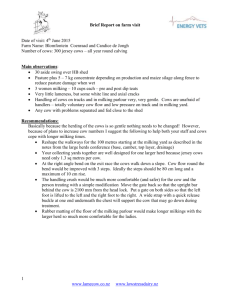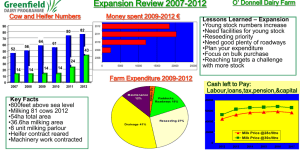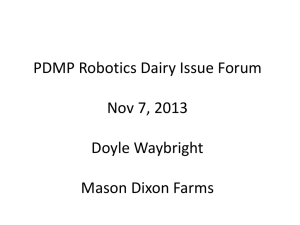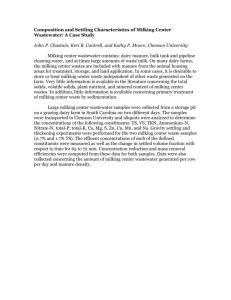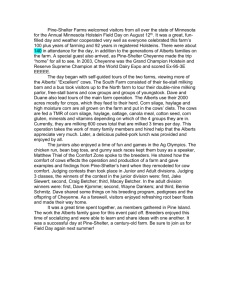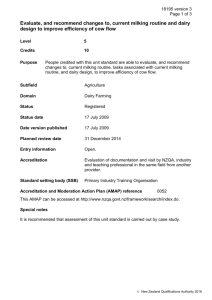Planning for cow movement through an automatic milking system
advertisement
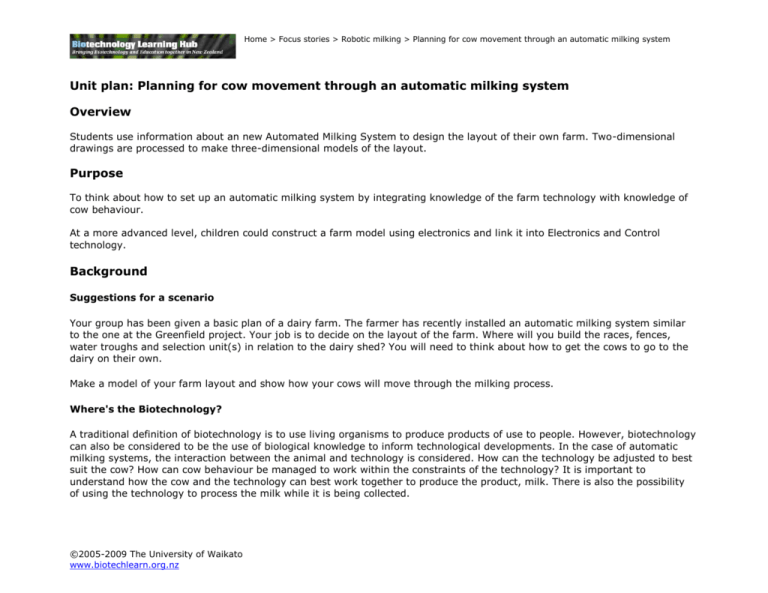
Home > Focus stories > Robotic milking > Planning for cow movement through an automatic milking system Unit plan: Planning for cow movement through an automatic milking system Overview Students use information about an new Automated Milking System to design the layout of their own farm. Two-dimensional drawings are processed to make three-dimensional models of the layout. Purpose To think about how to set up an automatic milking system by integrating knowledge of the farm technology with knowledge of cow behaviour. At a more advanced level, children could construct a farm model using electronics and link it into Electronics and Control technology. Background Suggestions for a scenario Your group has been given a basic plan of a dairy farm. The farmer has recently installed an automatic milking system similar to the one at the Greenfield project. Your job is to decide on the layout of the farm. Where will you build the races, fences, water troughs and selection unit(s) in relation to the dairy shed? You will need to think about how to get the cows to go to the dairy on their own. Make a model of your farm layout and show how your cows will move through the milking process. Where's the Biotechnology? A traditional definition of biotechnology is to use living organisms to produce products of use to people. However, biotechnology can also be considered to be the use of biological knowledge to inform technological developments. In the case of automatic milking systems, the interaction between the animal and technology is considered. How can the technology be adjusted to best suit the cow? How can cow behaviour be managed to work within the constraints of the technology? It is important to understand how the cow and the technology can best work together to produce the product, milk. There is also the possibility of using the technology to process the milk while it is being collected. ©2005-2009 The University of Waikato www.biotechlearn.org.nz Home > Focus stories > Robotic milking > Planning for cow movement through an automatic milking system Curriculum focus Technology Strand A: Children will explore the technology of an automatic milking system, identifying and depicting how the components are linked. Strand B: After gathering information and identifying needs and opportunities, children will discuss possible solutions and strategies and then select and develop a suitable option. They will prepare a plan of action, collect required resources, present a plan and model of a farm, and communicate ideas to others. Strand C: The children will identify and consider the positive and negative aspects of an automatic milking system from the perspective of the farmer and the cows. Science L2: AO4 Children will consider the responses of animals to environmental changes in their habitats. L3: AO4 Children will explain where and how cows live. Focus of skill & strategy Although a number of students will be familiar with the dairy farm, others will not. A visit to an ordinary dairy farm will expose the students to the milking process and to the behaviour required of the cows. Students should then explore robotic milking (see focus story). A visit from a dog handler could provide a focus for animal behaviour and how animals learn. A plan of the Greenfield farm when it was first set up can be used to introduce discussions on selection units, races, and one-way gate systems. Students can then plan their own farms in groups, producing simple farm models showing cow movement to and from the robotic milking machines. Role modelling during this process could help them sort out their ideas. Students will also develop skills to consider the ethical issues associated with using technology to manage cow behaviour. ©2005-2009 The University of Waikato www.biotechlearn.org.nz Home > Focus stories > Robotic milking > Planning for cow movement through an automatic milking system Resources Student activity: Action planner for an automatic milking system Student activity: Automatic milking system round robin Student activity: Farm plan for an automatic milking system Health and Safety Visits to farms should include safety consideration with regard to farm equipment and machines. Clothing and footwear should be appropriate. As docile as cows may seem, they are not pets and have the potential to harm. Children should not approach them. ©2005-2009 The University of Waikato www.biotechlearn.org.nz Home > Focus stories > Robotic milking > Planning for cow movement through an automatic milking system UNIT PLAN: PLANNING COW MOVEMENT THROUGH AN AUTOMATIC MILKING SYSTEM Suggested learning intentions Suggested learning experiences The following learning experiences will provide you with starting points for an exploration of this topic. You may decide to narrow your focus to one component, or include most of the ideas in a unit that incorporates science and/or technology themes. Understanding the milking system. An introduction to cows and the way they behave on a farm as part of the automatic milking system (AMS). Understanding the scenario and identifying the information that is needed to solve the problem ©2005-2009 The University of Waikato www.biotechlearn.org.nz Introduction Discussion on where milk comes from (have a carton of milk available). Brainstorm what the children already know about the production process (have pictures available). Visit a dairy farm. Focus on the cows’ behaviour. Ask the farmer questions about how they gets the cows to the shed. Ask about the temperament and nature of cows, etc. Farmers (students’ parents) could visit to tell stories about ‘clever’ cows and other quirks in cow behaviour (e.g., having preferred companions). Watch a video of the milking process, focusing on the behaviour of the cow(s). Introduce the scenario and prepare for action. Read out scenario. Brainstorm what do need to find out? (What is an AMS? What is the Greenfield project? How is ordinary farming different? What are cows like? How do you train cows?). Possible teaching/assessment activities Class brainstorm Farm visit Interviewing farmers Work as part of a group to develop an action plan Home > Focus stories > Robotic milking > Planning for cow movement through an automatic milking system Begin working on an action plan in groups of 3-5. What needs to be done first? Get student activity: Action planner for an automatic milking system Understanding the key components of an automatic milking system Exploring ways in which animal behaviour might be manipulated Developing students’ own ideas for a farm model using a plan, role play and constructing the model. ©2005-2009 The University of Waikato www.biotechlearn.org.nz Developing expertise Study automatic milking at the Greenfield Project farm. Get focus story: Robotic milking Look at the videos on the cow behaviour. How does it differ from the behaviour of cows on the farm that was visited? Have a dog handler visit the class with a trained dog. Children see what the dog is able to do. Discuss the dog’s training with the handler. Are all dogs the same to train? In small groups use role play to understand the use of incentives. One person has to read a very boring story. How will the others in the group entice that child to read? They could try different incentives, e.g. spinach, apple, lollies etc. Discuss what worked for that person. How might a cow be encouraged to do something they may not be so keen to do? Look at a original farm plan of the Greenfield project. Get student activity: Farm plan for an automatic milking system Discuss where the cows would have to go and what they would have to be trained to do. Also discuss how they might be trained. Taking action Individually or in groups, children use a basic farm plan showing topography and the position of the milking shed to design and draw a simple farm layout of their own. They should show the races, fences, and at least one selection unit. They also need to consider the terrain and Using the Biotechnology Learning Hub. Problem solving using role play. Considering cow movement within an automatic milking system. Design a written plan of the farm and use role play to consider problems that may arise with the proposed farm layout Make a model of the farm Home > Focus stories > Robotic milking > Planning for cow movement through an automatic milking system Animal welfare must be considered in the development and implementation of an automatic milking system on farms. ©2005-2009 The University of Waikato www.biotechlearn.org.nz walking distances. The group decides on a farm plan and use role play to visualise it. They could make paddocks and races with chairs in the classroom and have some of their group as the cows. The others could work out where they wanted the cows to go, what gates they would need, and what the cows would be required to do. The group makes a model from the plan. Children will need to decide on the materials they need and add them to the Action Planner. They could include cardboard, plasticine, match sticks, toy cows, etc. The group should consider where the cows need to go and how they will get there (what gates they will go through etc), what incentives could be used, and where they would put them. The incentives could be displayed as well. Considering the ethics From a cow’s point of view, what are the good things about living on a farm? (Protection, food, vet assistance, wouldn’t exist unless on a farm). What are the bad things? (Lameness from long periods of waiting at the dairy, mastitis, boredom – how could you tell?). See the news article: Tips for reducing a painful problem for cows. Using the format of a Automatic milking system round robin make a list of consequences that the farm plan would have for the cows and the people involved. Get student activity: Automatic milking system round robin In groups, using a PMI, look at the consequences and decide on the benefits (Plus), harm (Minus) and anything Interesting (that Present the model to an audience, explaining cow movement Write a summary of what the cows would need to do and how they would be trained Home > Focus stories > Robotic milking > Planning for cow movement through an automatic milking system ©2005-2009 The University of Waikato www.biotechlearn.org.nz might be worth investigating) in them. As a class, discuss the rights of the cow and of the farmer. Are the rights of the cow affected in your project? (for example the cow’s right to behave in a natural manner). Are the rights of the farmer affected? (for example the right to make their own decisions about how they work their farm).

